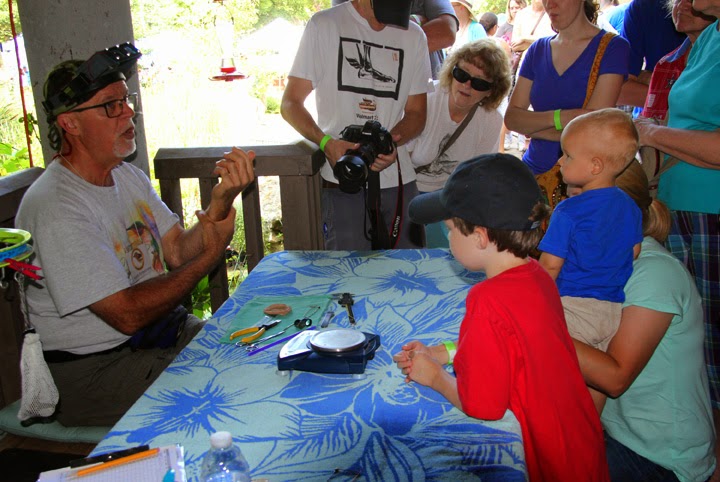One of the central attractions of the Wonder of Hummingbirds Festival each year is the hummingbird banding demonstrations given by Mark Armstrong, Master Bander of hummingbirds and songbirds.

Small groups make it easier for everyone to hear the bander and see the banding process. While visitors wait their turn, Oliver Lang, above, talks with visitors about hummers and banding. In another area, Mike Nelson describes the life of hummingbirds and how they are captured for banding. In the images below, Mike shows a tiny hummingbird nest to visitors from Indiana.
Photo credit: Billie CantwellHummingbirds are captured in wire traps that surround the feeder. The traps have a door that lifts open. Hummingbirds seeking nectar will go inside the trap to drink and the door, connected to a long fishing line, can be lowered once the hummer is inside.
Hummingbirds are attracted to nectar feeders and flowers. A large stand of Jewel Weed was present near the hummingbird banding area.
Photo credit: Jody Stone Jewel Weed is a favorite nectar blossom for hummingbirds
Hummingbirds that are captured in the traps are removed and carefully placed in a mesh bag to hold them until the bander is ready to process them. Hummingbirds, like other birds, feed more actively in the early morning hours.
Photo credit: Jody Stone
Master banders undergo many hours of training and receive a special certification that allows them to capture and band birds. Data collected is reported to the Bird Banding Laboratory in Bethesda, Maryland, and contributes to scientific knowledge about bird populations and migration patterns.
Before he removes the hummer from the bag. Mark explains what he is going to do and how the band fits on the hummingbird's leg.
He first checks to see if the hummingbird wears a band. Below, he uses a blunt darning needle as a tool to lift the hummers tiny foot and check its legs.
When no band is present, Mark places a new band on the hummer's leg with a special number series that will identify the bird if re-captured.
The band is closed around the leg with a special set of banding plyers.Photo credit: Karen Wilkinson
Above and below, Mark examines a male Ruby-throated Hummingbird using magnifying glasses. With a digital instrument, he measures the length of the beak.
Photo credit: Karen Wilkinson
Males, females and juveniles range in the length of their beaks, with the males generally having shorter beaks.
Above, Mark uses a magnifying loop to examine a juvenile's beak for grooving to help age the bird. Juvenile bills are still growing and have grooves while adults have no grooving
When the examination is complete, Mark shows visitors the banded hummer. Janie Kading (left) assists him during banding.
Photo credit: Karen Wilkinson
Watch for next years festival date on this blog's side bar. I will post it where you see the current year's date as soon as the 2015 date is decided!
Visit all the posts on this year's festival by clicking the link: Wonder of Hummingbirds--2014
Wonder of Hummingbird festival on Facebook
Wonder of Hummingbird Festival Blog
Wonder of Hummingbird Festival_2013
Wonder of Hummingbird Festival 2013 on Tennessee Wildside
KTOS on Facebook
Hummingbird Banding Demonstration 2009
Mark Armstrong, Master Bander
Knoxville Chapter of Tennessee Ornithological Society
Ijams Nature Center


























No comments:
Post a Comment